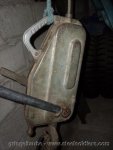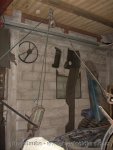I've used Grip Hoists for years and haven't had any problems with them. As with ANY piece of machinery from a pair of pliers to a 20K PTO winch, you can get yourself into trouble any time you over-estimate your abilities or the tool's capacity. Short-cuts usually aren't, and will often drag unwilling participants into the activities.
I know parts, even new ones, fail but a little extra time inspecting has often helped me find cracks or frays that could have been deadly under a load. Taking a second look at your set-up and rigging is worth the 'wasted time' if it prevents loss of equipment or people. By all means, get yourself a good recovery book and READ IT, don't just stuff it into your glove box.
The negatives of a Grip Hoist are; weight of the Grip Hoist "head" and the cable.
Since Grip Hoists crawl up their cable instead of reeling it onto a drum, you could make a 1,000 foot pull but who wants to lug around a thousand feet of cable?
Early Grip Hoists would only work with Grip Hoist cable, while the later ones designed for the military and U.S. markets will take any cable of the correct size.
On the plus side; you don't have to chock and re-rig every 20 feet or so.
That tree or boulder is no longer just out of reach.
They'll crawl down their cable too so you can lower as easily as you can raise.
The handle hub has shear pins to prevent you from overloading the Grip Hoist.
There's a de-clutching lever that makes taking up slack and take-down easy.
Another good item to have is a Lug-all. It's like a come-along on steroids. All cast aluminum construction and about twice as big as a come-along for any given cable size.
Observe and respect the Winch/come-along's rating. You'd be surprised how much force it takes to move a 3,000 pound Jeep when it's tires are buried and the frame is sitting on the ground. I'll give you a hint... it ain't 3,000 pounds.
NO winching machinery should be trusted to do a dead weight pull; but rather just exert enough pressure so the stuck vehicle can maintain headway or keep the tires bearing against the traction side of that mud wallow you've found yourself in.





